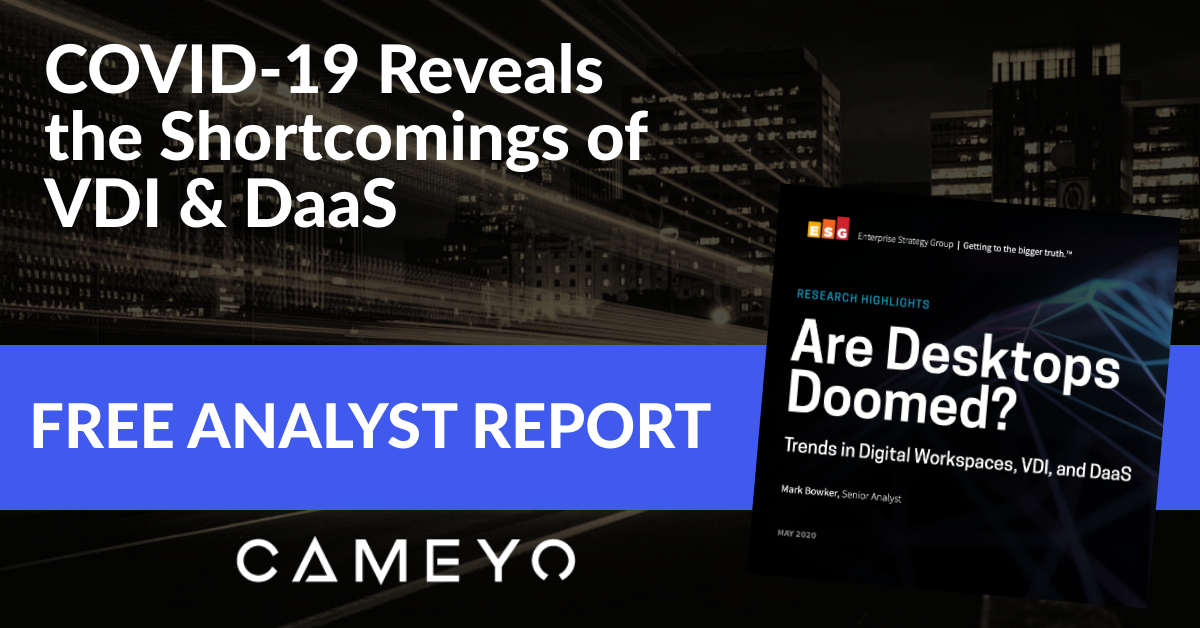For the past 3+ months, every organization has had to deal with the shift to remote work due to COVID-19. And as a new report by Enterprise Research Group (ESG) reveals, when faced with the need to enable people to work from home quickly, many organizations simply went with what they knew (or vendors they already worked with for other technology needs), which resulted in a large spike in people deploying (or attempting to deploy) virtual desktop infrastructure (VDI) or Desktop as a Service (DaaS) products. 
The ESG report shows that 4 out of 10 organizations are now using VDI or DaaS as a result. But more interesting is the fact that for both VDI AND DaaS users, the top three issues they report were:
- Cost
- Complexity
- Security
Interestingly, the current pandemic has created a situation which has accelerated the feedback loop on technologies for remote work, because organizations did not have the option to “slow roll” their deployments in phases, like many normally would. Due to COVID-19, organizations needed to roll out remote work solutions immediately – to everyone – meaning they had a lot of people stress-testing these solutions right away.
And as you can see in the announcement here, a key takeaway from the ESG analysts is that these key issues that most VDI and DaaS organizations are facing will likely hinder the long-term adoption of those technologies.
But, let’s be clear – this is not a condemnation of remote work technologies. This specifically shines a light on the shortcomings of legacy virtual desktop solutions like VDI and DaaS, and validates the shift that we’re already starting to see in the market. Because of the issues that IT regularly faces with legacy virtual desktops (VDI & DaaS), the industry is instead shifting to Digital Workspace solutions that were truly built for the cloud.
Need proof of this shift from virtual desktops to Digital Workspaces? Many of the legacy virtual desktop vendors like Citrix and VMware are already actively trying to rebrand their VDI and DaaS products as “Digital Workspace” products. But re-branding doesn’t change the problematic underlying technologies/architectures virtual desktops are built upon.
VDI is a collection of pre-cloud technologies that are deployed and managed by IT on-site to deliver a virtual desktop experience to their users. This requires significant investment in hardware and requires IT to manage servers, gateways, loads balancers, and other infrastructure. This is incredibly costly and complex, as the survey data shows, and also introduces a variety of attack surfaces from a security perspective. DaaS is essentially just VDI that has been crudely shoved into the cloud. DaaS sought to ‘disrupt’ VDI by moving certain aspects of virtual desktop delivery to the cloud, but it still relies on the same costly and complex underlying infrastructure.
Both VDI and DaaS are focused on delivering virtual desktops, but the industry is evolving from the legacy approach of virtual desktops to cloud-native Digital Workspaces that deliver an experience focused on seamless productivity for the end-user.
The goal of Digital Workspaces is to provide everyone with access to all of the applications and resources they need to be productive from anywhere, on any device, securely. This has led to the emergence of Virtual Application Delivery platforms like Cameyo, which provide everyone with a single location to securely access all of their Windows desktop and internal web apps on any device, from the browser, without the need for VPNs. Virtual Application Delivery eliminates the cost and management complexity involved in managing VDI and DaaS, provides a more seamless user experience that doesn’t require learning any new behavior, and enables the secure use of business-critical applications on any device – even non-IT managed personal devices.
So if your organization has had bad experiences with VDI and/or DaaS, or if you’ve been considering VDI/DaaS but have been reluctant due to the cost & complexity – consider a Digital Workspace approach like Cameyo. You can get started with a free trial here, and within minutes you’ll be able to publish your first applications with Cameyo and see how simple it is to enable remote productivity for your people.
Or, if you just want to dig into the data more, go ahead and download the full ESG report for free here.
